Giải các hệ phương trình sau:
Hãy nhập câu hỏi của bạn vào đây, nếu là tài khoản VIP, bạn sẽ được ưu tiên trả lời.

\(\left\{{}\begin{matrix}\left(x-5\right)\left(y-2\right)=\left(x+2\right)\left(y-1\right)\\\left(x-4\right)\left(y+7\right)=\left(x-3\right)\left(y+4\right)\end{matrix}\right.\)
\(\Leftrightarrow\left\{{}\begin{matrix}xy-2x-5y+10=xy-x+2y-2\\xy+7x-4y-28=xy+4x-3y-12\end{matrix}\right.\)
\(\Leftrightarrow\left\{{}\begin{matrix}x+7y=12\\3x-y=16\end{matrix}\right.\) \(\Leftrightarrow\left\{{}\begin{matrix}3x+21y=36\\3x-y=16\end{matrix}\right.\)
\(\Leftrightarrow\left\{{}\begin{matrix}22y=20\\x+7y=12\end{matrix}\right.\) \(\Leftrightarrow\left\{{}\begin{matrix}x=\dfrac{62}{11}\\y=\dfrac{10}{11}\end{matrix}\right.\)

1. 3x( x - 2 ) - ( x - 2 ) = 0
<=> ( x-2).(3x-1) = 0 => x = 2 hoặc x = \(\dfrac{1}{3}\)
2. x( x-1 ) ( x2 + x + 1 ) - 4( x - 1 )
<=> ( x - 1 ).( x (x^2 + x + 1 ) - 4 ) = 0
(phần này tui giải được x = 1 thôi còn bên kia giải ko ra nha )
3 \(\left\{{}\begin{matrix}\sqrt{5}x-2y=7\\\sqrt{5}x-5y=10\end{matrix}\right.\)<=> \(\left\{{}\begin{matrix}y=-1\\x=\sqrt{5}\end{matrix}\right.\)
\(1. 3x^2 - 7x +2=0\)
=>\(Δ=(-7)^2 - 4.3.2\)
\(= 49-24 = 25\)
Vì 25>0 suy ra phương trình có 2 nghiệm phân biệt:
\(x_1\)=\(\dfrac{-\left(-7\right)+\sqrt{25}}{2.3}=\dfrac{7+5}{6}=2\)
\(x_2\)=\(\dfrac{-\left(-7\right)-\sqrt{25}}{2.3}=\dfrac{7-5}{6}=\dfrac{1}{3}\)

a: \(\left\{{}\begin{matrix}\dfrac{12}{x-3}-\dfrac{5}{y+2}=63\\\dfrac{8}{x-3}+\dfrac{15}{y+2}=-13\end{matrix}\right.\)
\(\Leftrightarrow\left\{{}\begin{matrix}\dfrac{24}{x-3}-\dfrac{10}{y+2}=126\\\dfrac{24}{x-3}+\dfrac{45}{y+2}=-39\end{matrix}\right.\Leftrightarrow\left\{{}\begin{matrix}\dfrac{-55}{y+2}=165\\\dfrac{12}{x-3}-\dfrac{5}{y+2}=63\end{matrix}\right.\)
\(\Leftrightarrow\left\{{}\begin{matrix}y+2=\dfrac{-1}{3}\\\dfrac{12}{x-3}=48\end{matrix}\right.\Leftrightarrow\left\{{}\begin{matrix}y=-\dfrac{7}{3}\\x=\dfrac{13}{4}\end{matrix}\right.\)

\(a,\dfrac{x-3}{x}=\dfrac{x-3}{x+3}\)\(\left(đk:x\ne0,-3\right)\)
\(\Leftrightarrow\dfrac{x-3}{x}-\dfrac{x-3}{x+3}=0\)
\(\Leftrightarrow\dfrac{\left(x-3\right)\left(x+3\right)-x\left(x-3\right)}{x\left(x+3\right)}=0\)
\(\Leftrightarrow x^2-9-x^2+3x=0\)
\(\Leftrightarrow3x-9=0\)
\(\Leftrightarrow3x=9\)
\(\Leftrightarrow x=3\left(n\right)\)
Vậy \(S=\left\{3\right\}\)
\(b,\dfrac{4x-3}{4}>\dfrac{3x-5}{3}-\dfrac{2x-7}{12}\)
\(\Leftrightarrow\dfrac{4x-3}{4}-\dfrac{3x-5}{3}+\dfrac{2x-7}{12}>0\)
\(\Leftrightarrow\dfrac{3\left(4x-3\right)-4\left(3x-5\right)+2x-7}{12}>0\)
\(\Leftrightarrow12x-9-12x+20+2x-7>0\)
\(\Leftrightarrow2x+4>0\)
\(\Leftrightarrow2x>-4\)
\(\Leftrightarrow x>-2\)

b: Ta có: \(\left\{{}\begin{matrix}\left(x+5\right)\left(y-4\right)=xy\\\left(x+5\right)\left(y+12\right)=xy\end{matrix}\right.\)
\(\Leftrightarrow\left\{{}\begin{matrix}xy-4x+5y-20-xy=0\\xy+12x+5y+60-xy=0\end{matrix}\right.\Leftrightarrow\left\{{}\begin{matrix}-4x+5y=20\\12x+5y=-60\end{matrix}\right.\)
\(\Leftrightarrow\left\{{}\begin{matrix}-16y=80\\-4x+5y=20\end{matrix}\right.\Leftrightarrow\left\{{}\begin{matrix}y=-5\\-4x=20-5y=20-5\cdot\left(-5\right)=45\end{matrix}\right.\Leftrightarrow\left\{{}\begin{matrix}y=-5\\x=-\dfrac{45}{4}\end{matrix}\right.\)

e: \(\left\{{}\begin{matrix}\dfrac{1}{x}-\dfrac{1}{y}=1\\\dfrac{3}{x}+\dfrac{4}{y}=5\end{matrix}\right.\Leftrightarrow\left\{{}\begin{matrix}\dfrac{3}{x}-\dfrac{3}{y}=3\\\dfrac{3}{x}+\dfrac{4}{y}=5\end{matrix}\right.\)
\(\Leftrightarrow\left\{{}\begin{matrix}\dfrac{-7}{y}=-2\\\dfrac{1}{x}-\dfrac{1}{y}=1\end{matrix}\right.\Leftrightarrow\left\{{}\begin{matrix}y=\dfrac{7}{2}\\\dfrac{1}{x}=1+\dfrac{2}{7}=\dfrac{9}{7}\end{matrix}\right.\Leftrightarrow\left\{{}\begin{matrix}y=\dfrac{7}{2}\\x=\dfrac{7}{9}\end{matrix}\right.\)

c) \(\left\{{}\begin{matrix}2\left(x-2\right)+3\left(1+y\right)=2\\3\left(x-2\right)-2\left(1+y\right)=-3\end{matrix}\right.\)
\(\Leftrightarrow\left\{{}\begin{matrix}6\left(x-2\right)+9\left(1+y\right)=6\\6\left(x-2\right)-4\left(1+y\right)=-6\end{matrix}\right.\)
\(\Leftrightarrow\left\{{}\begin{matrix}13\left(1+y\right)=12\\2\left(x-2\right)+3\left(1+y\right)=2\end{matrix}\right.\)
\(\Leftrightarrow\left\{{}\begin{matrix}x=\dfrac{21}{13}\\y=-\dfrac{1}{13}\end{matrix}\right.\)
d) \(\left\{{}\begin{matrix}\left(x-5\right)\left(y-2\right)=\left(x+2\right)\left(y-1\right)\\\left(x-4\right)\left(y+7\right)=\left(x-3\right)\left(y+4\right)\end{matrix}\right.\)
\(\Leftrightarrow\left\{{}\begin{matrix}xy-2x-5y+10=xy-x+2y-2\\xy+7x-4y-28=xy+4x-3y-12\end{matrix}\right.\)
\(\Leftrightarrow\left\{{}\begin{matrix}-x-7y=-12\\3x-y=16\end{matrix}\right.\) \(\Leftrightarrow\left\{{}\begin{matrix}-x-7y=-12\\21x-7y=112\end{matrix}\right.\)
\(\Leftrightarrow\left\{{}\begin{matrix}22x=124\\3x-y=16\end{matrix}\right.\) \(\Leftrightarrow\left\{{}\begin{matrix}x=\dfrac{62}{11}\\y=\dfrac{10}{11}\end{matrix}\right.\)

Bài toán này có hai cách giải:
Cách 1: Thu gọn từng phương trình ta sẽ thu được phương trình bậc nhất hai ẩn x và y.
Cách 2: Đặt ẩn phụ.
Cách 1:

 (hệ số của y bằng nhau nên ta trừ từng vế hai phương trình)
(hệ số của y bằng nhau nên ta trừ từng vế hai phương trình)
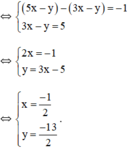
Vậy hệ phương trình có nghiệm duy nhất 
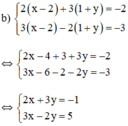
(Nhân hai vế pt 1 với 2; pt 2 với 3 để hệ số của y đối nhau)
 (Hệ số của y đối nhau nên ta cộng từng vế của hai pt)
(Hệ số của y đối nhau nên ta cộng từng vế của hai pt)
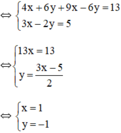
Vậy hệ phương trình có nghiệm duy nhất (1; -1).
Cách 2:
a) Đặt x + y = u và x – y = v (*)
Khi đó hệ phương trình trở thành
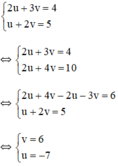
Thay u = -7 và v = 6 vào (*) ta được hệ phương trình:
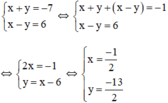
Vậy hệ phương trình có nghiệm 
b) Đặt x – 2 = u và y + 1 = v.
Khi đó hệ phương trình trở thành :
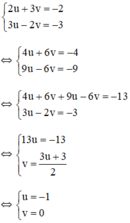
+ u = -1 ⇒ x – 2 = -1 ⇒ x = 1.
+ v = 0 ⇒ y + 1 = 0 ⇒ y = -1.
Vậy hệ phương trình có nghiệm (1; -1).
Hệ phương trình đã cho có vô số nghiệm (x; y) thỏa mãn